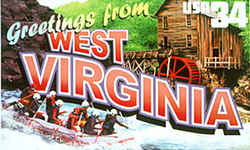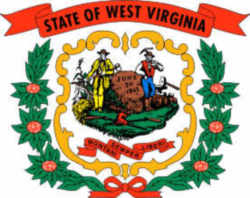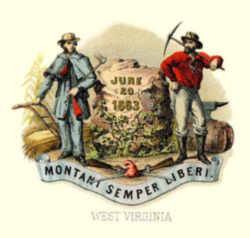
West Virginia Symbols
West Virginia State Coat of Arms
State Coat of Arms

Adopted on September 26, 1863.
The Great Seal of West Virginia, which is also the Coat of Arms, was adopted by the Legislature on September 26, 1863.
It symbolizes the principal pursuits and resources of West Virginia.
The coat of arms of West Virginia were taken from The Great Seal of the State of West Virginia which was adopted in 1863. The center of the seal contains a boulder that has been inscribed June 20, 1863, the date West Virginia became a state. In front of the boulder lies two crossed rifles and a liberty cap to state the State's importance of fighting for liberty. The two men on either side of the boulder represent agriculture and industry. On the left stands a farmer with an ax and plow before a cornstalk. On the other side stands a miner with a pickaxe, and behind him an anvil and sledge hammer. The outer ring contains the text 'State of West Virginia' and the state's motto 'Montani Semper Liberi', ('Mountaineers are Always Free'; the state nickname is 'the Mountain State').
West Virginia State Coat
of Arms:
State Coat of Arms

Described briefly, the Seal bears the legend, "State of West Virginia", together with the motto, "Montani Semper Liberi" (Mountaineers Are Always Free); a farmer stands to the right and a miner to the left of a large ivy-draped rock bearing the date of the State's admission to the Union. In front of the rock are two hunters' rifles upon which rests a Phrygian Cap, or "Cap of Liberty". Joseph H. Diss Debar of Doddridge County designed the State Seal in 1863 at the request of the first West Virginia Legislature.
The West Virginia Legislature approved Senate Joint Resolution No. 18 on March 7, 1929. Resolution No. 18 described the West Virginia State flag the flies over the Capitol today.
West Virginia Senate Joint Resolution No. 18
WHEREAS, The legislature of West Virginia, by joint resolution passed on the twenty-fourth day of February, one thousand nine hundred
and five, adopted a state flag, prescribing the design thereof; and
WHEREAS, The design so adopted is impractical of manufacture, making the cost of purchase thereof prohibitive to the schools of the state and others
desiring to purchase said flag; and
WHEREAS, There has been worked out a design embodying all of the features of the first West Virginia state flag so adopted, but so designed as to be
practical of manufacture at a reasonable cost to those desiring to purchase the same; and
WHEREAS, It seems desirable to change the design of the West Virginia state flag; therefore, be it
RESOLVED BY THTE LEGISLATURE OF WEST VIRGINIA:
That the Legislature of West Virginia hereby adopts a State Flag of the following design and proportions, to-wit:
The proportions of the flag of the State of West Virginia shall be the same as those of the United States ensign; the field shall be pure white, upon
the center of which shall be emblazoned in proper colors, the coat-of arms of the State of West Virginia upon which appears the date of the admission
of the State into the Union, also with the motto, 'Montani Semper Liberi' (Mountaineers Are Always Free). Above the coat-of-arms of the State of West
Virginia there shall be a ribbon lettered, 'State of West Virginia,' and arranged appropriately around the lower part of the coat-of-arms of the State
of West Virginia a wreath of Rhododendron maximum in proper colors. The field of pure white shall be bordered by a strip of blue on four sides. The
flag of the State of West Virginia when used for parade purposes shall be trimmed with gold colored fringe on three sides and when used on ceremonial
occasions with the United States ensign, shall be trimmed and mounted in similar fashion to the United States flag as regards fringe, cord, tassels,
and mounting."







